|
Thurs., July 26
8:00 a.m. - 5:00 p.m.
Toward the ILC: A Fermilab Community School on R&D Challenges and Opportunities - One West
8:00 a.m. - 5:00 p.m.
Open Science Grid Users' Meeting
2:30 p.m.
Theoretical Physics Seminar - Curia II
Speaker: P. Hung, University of Virginia
Title: Electroweak-Scale Right-Handed Neutrinos
3:30 p.m.
DIRECTOR'S COFFEE BREAK - 2nd Flr X-Over
4:00 p.m.
Accelerator Physics and Technology Seminar - One West
Speaker: A. Seryi, Stanford Linear Accelerator Center
Title: ILC Beam Delivery System
Fri., July 27
8:00 a.m. - 5:00 p.m.
Open Science Grid Users' Meeting
3:30 p.m.
DIRECTOR'S COFFEE BREAK - 2nd Flr X-Over
4:00 p.m.
Joint Experimental - Theoretical Physics Seminar - One West
Speaker: M. Harrison, Brookhaven National Laboratory
Title: U.S. ILC R&D Plans
Click here for NALCAL,
a weekly calendar with links to additional information. |
Thursday, July 26
- Minnesota Wild Rice w/Chicken
- Tuna Melt on Nine Grain
- BBQ Ribs
- Chicken Casserole
- Buffalo Chicken Wrap
- Assorted sliced pizza
- Toasted Pecan Chicken Salad
*Carb Restricted Alternative
Wilson Hall Cafe Menu |
|
Thursday, July 26
Dinner
- Pasta w/roasted summer vegetables
- Veal saltimbocca
- Sautéed spinach w/lemon & pine nuts
- Peach melba
Wednesday, August 1
Lunch
- Parsley poblano salad w/orange glazed beef
- Blueberry cobbler
Chez Leon Menu
Call x4598 to make your reservation. |
|
|
Books not required: ILC School begins at Fermilab
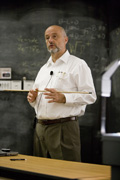 |
| Fermilab Director Pier Oddone addresses attendees at the ILC School Wednesday morning. |
Fermilab employees and users sat attentively in the One West conference room Wednesday morning, eager to learn more about ongoing plans for the International Linear Collider. Wednesday was the first day of the three-day ILC Community School, which aims to educate attendees about ILC plans and design efforts by Fermilab and the international scientific community.
"I am happy to see that you are all here, getting your heads into the ILC," said Fermilab Director Pier Oddone in his opening remarks. "It is a dream for all of us and something that we hope will come to Fermilab."
In his morning talk, Fermilab ILC Program Director Bob Kephart gave a comprehensive overview of the ILC, focusing on the design and R&D challenges and opportunities that the ILC community faces while working toward an engineering design. "The Engineering Design report will provide the basic ingredients on a decision," Kephart said.
 |
| Fermilab ILC Program Director Bob Kephart gave ILC School attendees an introduction to the ILC Wednesday. |
Although some talks this week may be technical, "you don't have to be an accelerator physicist to engage in this," said Kephart. "There are lots of places where lab users, university groups and students can contribute." The schedule of today's progtram can be found here.
On Friday at 2:45 p.m., the entire laboratory community is invited to join a non-technical discussion titled "What will the neighbors think?" with key ILC Citizens' Task Force members. The ILC Citizens' Task Force provides Fermilab with advice and guidance on the planning for the ILC from a community point of view.
-- Rhianna Wisniewski
|
Computing Division celebrates annual picnic
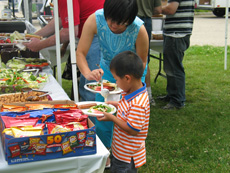
Computing Division employees enjoy catered food and sunshine at their annual picnic yesterday. Around 250 people gathered at the Kuhn Barn in the Village to celebrate the Division's achievements from the past year.
|
Data for the people: how to fast-track your network and share the data love

"You don't have to have a PhD to be interested in data and to want to analyze it. " Bob Grossman is working to make large data sets easily accessible and publicly available, even to children.
Stock image from sxc.hu
So you've used a grid to split up your job, process it faster, then return your results. You now have a nice chunky terabyte of data. What do you do with it?
Bob Grossman, Director of the National Center for Data Mining at the University of Illinois, Chicago, U.S., says the answer is share, share, share.
"In terms of impact on society, the ability to use transparently other people's data is going to be transforming," Grossman says.
Read More
-- Cristy Burne, iSGTW
|
From PhysOrg.com
July 25, 2007
WIPP Clean Rooms Set Up for Experiments
(AP) -- Two multi-ton clean rooms have been lowered into the Waste Isolation Pilot Plant for eventual physics experiments that need to be shielded from cosmic rays and naturally occurring radiation on the surface of the Earth.
WIPP, a Department of Energy's nuclear waste repository in salt beds 2,150 feet below the surface, will be the host for the next several years for a high-energy physics project called EXO.
"It's ironic a little bit that a salt mine with megacuries of nuclear waste in it can be a low radioactive background area," Roger Nelson, chief scientist for the DOE at WIPP, said Tuesday.
Read more
|
|
|
Looking beyond the standard with top
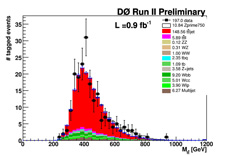
Top-antitop invariant mass spectrum. The points are the DZero data, the colored histograms show the standard model predictions and the open histogram shows the signal expected from a hypothetical Z-prime with a mass of 750 GeV.
As the most massive known elementary particle, the top quark provides a window to phenomena outside the standard model. DZero has examined top quark samples in the lepton + jets channel from 1 fb-1 of Tevatron data to search for signs of non-standard physics.
Many theoretical models predict the existence of massive copies of the Z boson, called Z-prime. In some models the Z-prime decays preferentially to top-antitop pairs. DZero has searched for narrow Z-prime resonances in the invariant mass spectrum of within a particular Topcolor model, Z-prime bosons have been excluded with masses below 680 GeV.
If the Z-prime is a broad resonance then its signal in the top-antitop mass spectrum would be too smeared out and will escape detection. DZero has invented a new method to catch it by measuring, for the first time, the forward-backward charge asymmetry in top-antitop pair production. The standard model predicts a small asymmetry (0.8 percent) but a Z-prime that couples to top-antitop in the same way as the standard Z boson could result in measured asymmetries up to 38 percent. DZero measures an asymmetry of (12±8) percent, consistent with the standard model expectation and limiting the possible admixture of Z-prime bosons with masses between 550 and 1,000 GeV.
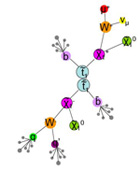 |
| Schematic representation of stop-antistop decay in the lepton+jets channel. |
Yet another possibility is that decays of stop-antistop pairs, top's superpartners, are hiding among the observed top-antitop signal events. A stop particle may decay to a b-quark and a W boson plus a neutralino (see graphic at left), the lightest supersymmetric particle which is stable and escapes detection, giving rise to a very similar signature as top quark decay. DZero exploited the kinematic differences between stop and top decay to set upper limits on the stop-antistop production cross section of 3 to 7 pb, depending on the assumed superpartner masses.
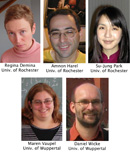 |
Regina Demina, Amnon Harel, Su-Jung Park, Maren Vaupel, and Daniel Wicke made primary contributions to these analyses. |
|
|
Travel offices moving today
The Fermilab Travel office and the foreign travel office will be permanently moving on Thursday, July 26 from their first floor location to the fourth floor of Wilson Hall, WH4SE.
What do the Neighbors Think?
Friday at 2:45 p.m. in One West, seven members of the ILC Citizens' Task Force will present some of the challenging questions that Fermilab's neighbors are asking about the ILC. The entire Fermilab community is invited to help find the answers at this special session of the ILC Community School.
Salary Review Process Location Change
General information for all employees on updates to the salary review process is now available online. Please review this presentation. If you have any questions on the information provided or any topic related to the upcoming salary review, please attend one of the town-hall meetings scheduled for 1:30 p.m. on July 25, 26, and 31 in Wilson Hall, Auditorium.
Professional Development classes
New classes are always being added to the professional development schedule. For the most up-to-date course offerings, visit the training web site.
Contribute your music
to labwide party
In keeping with the international flavor of the labwide party on Friday, August 3, the party organizers and the DJ invite you to contribute CDs with up to three tracks of your favorite party music from your home country for play during the party. Please label the CDs with your name, mail station and e-mail address and bring them to Judy Treend, Office of Public Affairs, WH1NE, by 5 p.m. on Monday, July 30.
DOE Launches Search Site
The Department of Energy has launched the Science Accelerator, a one-stop search tool to search the OSTI's key collections. The new service
deploys federated search technology to retrieve results ranked by relevancy. |
|